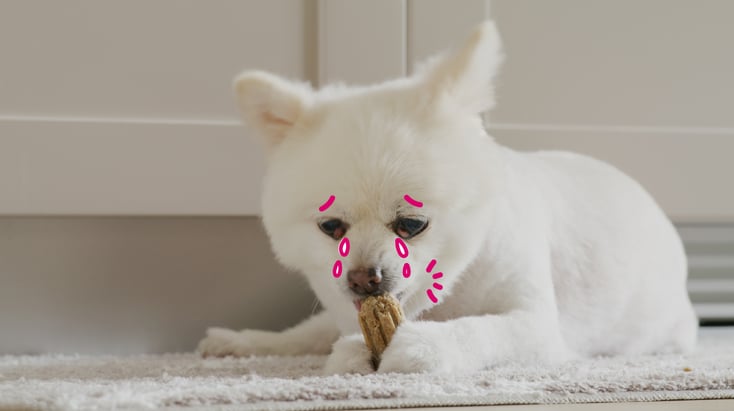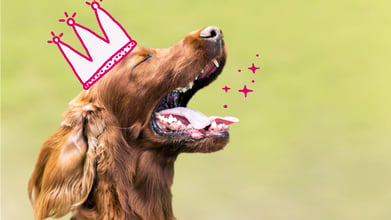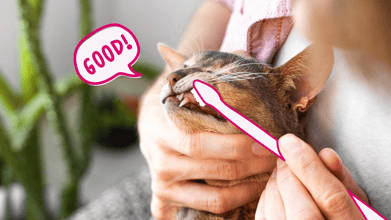Dental Care for Dogs: 4 Ways You Can Help

Table of Contents
Ensuring your dog receives proper dental care is crucial for their overall well-being. As a veterinarian, I emphasize the importance of recognizing signs of poor dental health and taking proactive measures to address it.
In this article, I'll share four tips for effective dental care for dogs. These include making smart diet choices, implementing regular toothbrushing, using oral products, and seeking veterinary treatment when necessary. By prioritizing your dog's dental health, you can ensure they enjoy a pain-free and healthy smile for years to come.
How Can You Improve Your Dog’s Dental Health?
To improve your dog's dental health, focus on their diet, brush their teeth regularly, consider using oral products, and seek veterinary treatment when needed. Here is a breakdown of these tips to improve your dog's oral hygiene:
1. Diet
Any food that causes abrasion on the teeth can help to remove plaque and disrupt the layer of bacteria that builds up on the teeth. Safe food options include prescription dental formula and other dry foods (feeding dry kibble instead of wet or meat-based diets is better for a dog’s teeth), dog chews, raw carrots (and other dog-safe veggies),
It might be tempting to reach for other tough objects like bones, rawhide, and antlers, but be aware that these materials can splinter, cause gut obstructions, and damage teeth. Consult with a veterinary nutritionist if your dog needs diet planning.
2. Toothbrushing
Brushing your dog’s teeth will disrupt the biofilm of bacteria and prevent plaque formation if it’s performed at least every other day. However, it won't remove existing tartar, only a veterinary scale and polish can do that. It's still very beneficial for halting the progress of dental disease or keeping your dog's teeth in good condition after a scale and polish.
You should use pet-safe toothpaste, and you can choose a fingertip brush or standard dog toothbrush depending on what suits you and your furry friend best.
3. Other Oral Products
If brushing your dog's teeth isn't practical because they are very nervous, head-shy, or painful, other options are available. Antibacterial gels, mouthwashes, and water supplements can also help to keep your dog's teeth healthy by reducing plaque buildup and bacteria.
4. Veterinary Treatment
Sadly, dental disease isn't always reversible, even with a scale and polish. The tartar can be removed, but if it has been present for a while and the gums, tooth root, and socket structures have become affected, there could be permanent damage.
This could mean that regular tooth brushing is required to prevent further damage that could cause tooth loss, or it may mean that the tooth is already so unstable or damaged that it needs to be extracted.
Thankfully, dogs can manage well with fewer teeth and are often much more comfortable just a day or two after the procedure.
Pet Dental Health Quiz
1. How often do you brush your pet’s teeth at home?
2. What color are your pet’s teeth?
3. When you look at your pet’s gums, which best describes what you see?
4. When you check your pet’s teeth, what do you see?
5. How does your pet respond to having their teeth or mouth touched?
6. When my pet eats, they:
7. When you kiss your pet you notice…
View Results
Risks of Bad Dental Health in Dogs
The risks of poor dental health in dogs include significant pain. While dogs may not express pain in the same way as humans, dental disease can cause chronic discomfort. In severe cases, dental infections can spread to the bloodstream, resulting in conditions like sepsis or bacterial infection of the heart valves (endocarditis).
Signs & Symptoms of Poor Dental Health in Dogs
Here are some common signs that indicate poor dental health in dogs:
- Bad breath: Noticeable foul odor coming from your dog's mouth.
- Increased drooling: More drooling than usual.
- Decreased appetite: Reduced interest in food or reluctance to eat.
- Difficulty eating: Dropping food, favoring one side of the mouth, or showing pain while eating.
- Vocalization or pawing at the mouth: Yelping or pawing at the mouth during eating, indicating discomfort or pain.
- Weight loss: Unexplained weight loss despite a normal diet.
Should My Pet Be Seen by a Veterinarian?
1. Have you noticed changes in your pet’s appetite?
2. Does your pet have diarrhea or loose stools?
3. Have you noticed changes in your pet’s thirst/water consumption?
4. Is your pet having accidents in the house?
5. Is your pet pacing and unable to settle?
6. Is your pet panting more than usual?
7. Is your pet whining or vocalizing more than usual?
8. Is your pet shaking more than usual?
9. Is your pet hiding or avoiding physical contact more than usual?
10. Is your pet more lethargic and sleeping more than usual?
11. Are you concerned about changes in your pet’s behavior?
12. Is your pet scratching their ears?
13. Is your pet licking their paws more than usual?
14. Does your pet have a rash?
15. Is your pet moving more slowly than usual or having a harder time getting up or down?
View Results
Should My Pet Be Seen by a Veterinarian?
1. Have you noticed changes in your pet’s appetite?
2. Does your pet have diarrhea or loose stools?
3. Have you noticed changes in your pet’s thirst/water consumption?
4. Is your pet having accidents in the house?
5. Is your pet pacing and unable to settle?
6. Is your pet panting more than usual?
7. Is your pet whining or vocalizing more than usual?
8. Is your pet shaking more than usual?
9. Is your pet hiding or avoiding physical contact more than usual?
10. Is your pet more lethargic and sleeping more than usual?
11. Are you concerned about changes in your pet’s behavior?
12. Is your pet scratching their ears?
13. Is your pet licking their paws more than usual?
14. Does your pet have a rash?
15. Is your pet moving more slowly than usual or having a harder time getting up or down?
Share Quiz
When to Seek Veterinary Care
If you're concerned about your dog's oral health, take a moment to examine their mouth safely. Look out for signs like plaque, tartar buildup, and gingivitis, as well as the symptoms mentioned earlier. If you notice any of these issues, it's important to seek veterinary care.
Dental disease is quite common in dogs, but it often goes unnoticed, especially in the early stages. By staying proactive, maintaining your dog's oral hygiene at home, and seeking veterinary assistance when needed, you can ensure your furry friend stays happy and pain-free, with plenty of reasons to smile for years to come.
Related reading: How Often Should I Take My Dog to the Vet?
Conclusion
In conclusion, maintaining your dog's dental health is crucial for their overall well-being. By following these tips, you can keep their teeth in optimal condition. Remember to choose a suitable diet, prioritize regular toothbrushing, and utilize beneficial oral products.
If you have concerns about your dog's oral health, don't hesitate to schedule a dental check-up with a veterinarian. Together, we can ensure your dog's smile remains healthy and free from discomfort.
Frequently Asked Questions
What does dental disease look like?
If your dog has periodontal disease, their teeth may be covered with softer plaque or mineralized tartar. The gums surrounding the teeth might look red and inflamed, and the tooth roots might be visible. If the dental disease is quite severe, you might also notice blood or pus in the mouth. Of course, there are other causes of mouth problems in dogs, so check with your vet if you’re not sure.
Can you reverse dental decay in dogs?
Tooth decay can be reversed in its early stages. However, once the gums have begun to recede and the ligament and bone surrounding the tooth are compromised, the changes are irreversible.
What foods are good for dogs’ dental health?
Hard foods that cause friction on the teeth are good for your dog's teeth. Raw carrots, dry dog food, and dental chews are all good options. You should avoid offering bones, antler chews, and other hard materials that could cause gut obstructions or damage the teeth or mouth.
How can I soften the plaque on my dog’s teeth?
Plaque isn’t mineralized, so that it can be removed with regular tooth brushing. However, once it becomes mineralized calculus, it can only be removed with an ultrasonic scaler used by a veterinarian or qualified veterinary technician.





